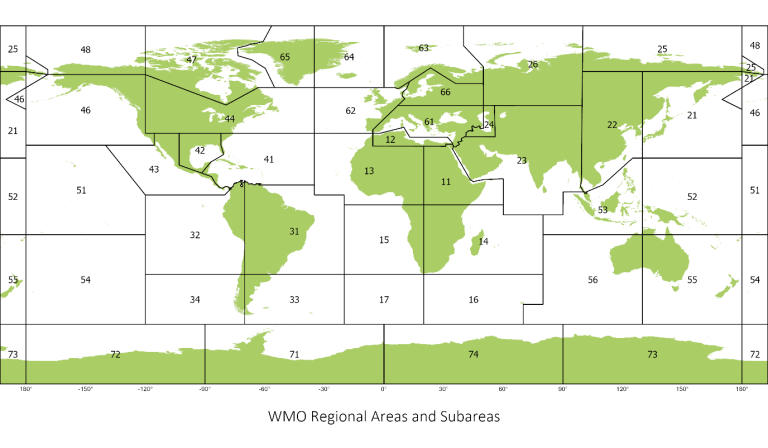Rules for allocating WMO numbers
WMO = World Meteorological Organization
WIGOS = WMO Integrated Global Observing System
WSI = WIGOS Station Identifier
What is a WSI?
WMO Integrated Global Observing System (WIGOS) Station Identifiers (WSI) are allocated for observing platforms/stations sharing their data on the Global Telecommunication System (GTS), WMO Information System (WIS) 2.0 and/or other web-based data assembly and sharing systems. These identifiers are critical to set up operational and interoperable data and metadata flows.
Issuance of the WSI for the platforms/stations of the GOOS in situ observing networks is delegated to the OceanOPS support centre, (WMO office in France, part of the WMO Infrastructure Department and Earth System Monitoring Division) as documented in the Manual on the WMO Integrated Global Observing System (WMO-No. 1160) Chapter 2.4. The WSI and the scheme to allocate local identifiers are described below and detailed as well in the Guide to WMO Integrated Global Observing System (2021 update, Chap. 10.2). The system of WIGOS station identifiers is defined in the Manual on the WMO Integrated Global Observing System (WMO-No. 1160), Attachment 2.2.
Table 1: The WIGOS Station Identifiers structure.
| WIGOS Identifier Series (number) | Issuer of Identifier (number) | Issue Number (number) | Local Identifier (characters) |
| 0 | 22000 | 0 to 65534 | 7-character string |
The two first blocks are constants, and the two others are allocated by OceanOPS system. The issue number is used to capture e.g., the different missions of a subsurface gliders, or deployment/servicing of a moored buoy. By convention, the WSI will be represented as follows (in the context of WIGOS): <WIGOS station identifier series>-<issuer of identifier>-<issue number>-<local identifier>
The local identifier allocation rule is described in Table 2 below. It depends on the platform type (surface drifter, subsurface profiling floats, moored buoy, etc), and, in the case of fixed platforms only, it depends also on the deployment area (vs WMO areas map below Figure 1).
Table 2: Rules for local identifier allocation
| Platform type | Local identifier | Reallocation |
| Profiling floats, micro floats, ice tethered profilers, polar ocean profiling systems, deep floats, etc. | N9nnnnn | No |
| Marine animals | 99nnnnn | No |
| Subsurface autonomous platforms, gliders | 89nnnnn | Yes (issue number incremented) |
| Surface drifters, ice drifters | N8nnnnn | No |
| Other autonomous surface instruments (saildrones, wave gliders, etc.) | N0nnnnn | No |
| Fixed systems, moored buoys, mooring sites, HF radars, tide gauges, etc | ABnnnnn | Yes (issue number incremented) |
| Any ship-based instruments | saasssa | No |
| Reserve of free blocks for future platform types | 80nnnnn, 82nnnnn, 83nnnnn, 84nnnnn, 85nnnnn, 86nnnnn, 87nnnnn | n/a |
n = numeric character, a = alphabetic character, s = alphanumeric character, N ∈ (1,2,3,4,5,6,7)
A, B ∈ (1,2,3,4,5,6,7) matching with WMO regional areas and subareas (Figure 1)
Examples:
“0-22000-0-4902589" is the WIGOS Station Identifier of a Canadian profiling float.
“0-22000-24-3100007"is the WSI of a moored buoy deployment operated by USA in WMO area 31
“0-22000-0-VYDDKYM" is the WSI of a French ship based automatic weather station
How to get WSI?
OceanOPS offers web tools to enable users to get new WSI local identifiers and build the complete and truly unique WSI.
STEP 1 - PREREQUISITES: Create an account on www.ocean-ops.org and contact the OceanOPS team (support ocean-ops [dot] org (support[at]ocean-ops[dot]org))
ocean-ops [dot] org (support[at]ocean-ops[dot]org))
- The user needs to have an OceanOPS account.
- The user must be granted write access for a specific Program (created by OceanOPS and referenced in WIGOS table 2-02).
STEP 2: login to www.ocean-ops.org and select Submit/Request Ids.
- “How-to” video: request identifiers on OceanOPS web application.[AL1]
Users are encouraged to access the interface to request identifiers for instruments that they are going to operate. The application is available 24/7, including web services (REST API - for machine-to-machine processes), thus it is not needed to reserve large batches years in advance.
Note that the request will:
- Allocate a random local identifier according to the scheme (see Table 2)
- Initialize a metadata record in OceanOPS
- Allocate the full WSI (see Table 1)
If several identifiers are requested at a time, given the randomization introduced, the formation of a sequence is not guaranteed: allocated identifiers will not necessarily follow each other.
The mandatory metadata to get identifiers are the program and the deployment date (approximative date), and the location for fixed systems. Other metadata can be provided during the request. For each record, the metadata can be easily customized by the user before submitting the request.
Through the web interface, a user can request a maximum of 100 identifiers at a time. This is done to reasonably limit the number of identifiers requested at once and encourage stronger metadata management from the start. A recycling process will be set up to release unused identifiers (with no further metadata provided, or no confirmation of the deployment, or no observations shared) after a given time.
For a detailed description of the WSI allocation tools, please refer to the OceanOPS metadata documentation.
For support and guidance, please contact support ocean-ops [dot] org (support[at]ocean-ops[dot]org).
ocean-ops [dot] org (support[at]ocean-ops[dot]org).
Figure 1: WMO regional area (A, 1st digit) and sub-area (B, 2nd digit) for allocation of WMO numbers based upon deployment area (only for the fixed platforms)

Resources
- Manual on the WMO Integrated Global Observing System (WMO-No. 1160)
- Guide to WMO Integrated Global Observing System (WMO-No. 1165)
- OceanOPS web application (dashboard)
- OceanOPS metadata documentation
How to request WMO/WIGOS identifiers on OceanOPS web app
